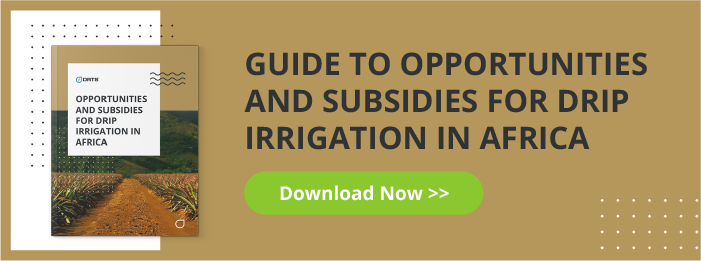Africa is home to nearly 200 million hectares of unused arable land, making up for half of the world’s uncultivated arable land. It, therefore, comes to no surprise that African governments, as well as organizations such as The World Bank, aim for agricultural reform providing incentives to leverage the abundance of land to ensure sustained agricultural growth for the continent. This has led to a series of positive actions such as farm subsidies, tax benefits, access to low interest bank loans and funding from privately owned trusts or non-profit organizations meant to help farmers and farming product companies alike.
These financial incentives combined with Africa’s large farming market potential, provide manufacturers with a very good platform for selling drip irrigation products.
How farm subsidies benefit irrigation manufacturers & farmers
The larger part of Africa’s cultivated land is almost entirely dependent on rainfall, resulting in fluctuating yields and product quality. For that reason, most African countries provide a variety of farm subsidies for installing or upgrading drip irrigation equipment. In many cases, such as in countries like Nigeria, Cameroon, Malawi and Ethiopia, these subsidies are backed by budgets of hundreds of millions of dollars.
These subsidies provide local African farmers with the necessary funds required for purchasing and maintaining drip irrigation equipment, which they may otherwise not have been able to afford or would simply not invest in. Farmers that use drip irrigation will no longer rely on rain-fed irrigation, becoming independent of seasons and rainfall or surface irrigation. Once farmers benefit from drip irrigation and increase their production yield, they maintain that practice and become lifelong drip irrigation users. This creates market demand, providing manufacturers with an entry point to the market, allowing them to sell more drip irrigation products.
Drip irrigation equipment is not a one-off purchase for a farm, but an irrigation practice requiring periodical maintenance and the purchase of new equipment, as for example in the case of thin wall tape which is good for a single season and must be replaced in every farming cycle. Farm subsidies not only allow for initial investment but also give farmers the change to periodically maintain their drip irrigation equipment as necessary, effectively creating a steady sales and income stream for manufacturers.
Beyond the subsidies
Even though farm subsidies provide an excellent starting point for manufacturers to gain a foothold in the irrigation products market, the business opportunities for a drip irrigation products manufacturer certainly are not limited to just subsidies.
Drip irrigation manufacturers have been highly successful, expanding their market through exports of drip irrigation products, as well as diversifying to cover fields other than the agricultural and farming industry, such as the specialized drip irrigation equipment used in the leach mining industry.
Discover available subsidies & opportunities
Emerging markets with high farming potential such as the African continent, present a lucrative opportunity for drip irrigation industry adopters, be it manufacturers and farmers alike.
For more information on available subsidies, opportunities and financial incentives for the African continent, download the latest edition of the DRTS Guide to Opportunities and Subsidies for Drip Irrigation in Africa. Or contact us to get a free consultation and learn how DRTS can help you set up your own drip irrigation pipe production line
More from DRTS
Top African Irrigation Subsidies to Help You Grow Your Business
New Agricultural Subsidies in Nigeria – Opening the Market for Drip Irrigation
Technical Considerations When Designing a Plastic Pipe Factory
Drip Irrigation: New Trends & Emerging Industries
Guide to Opportunities and Subsidies for Drip Irrigation Machinery in Africa






